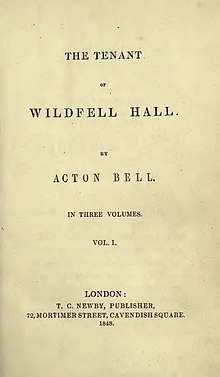 Title page of the first edition, 1848 | |
| Author | Anne Brontë (as "Acton Bell") |
|---|---|
| Language | English |
| Genre | Epistolary novel, social criticism |
| Publisher | Thomas Cautley Newby |
Publication date | 24 June 1848[1] |
| Publication place | United Kingdom |
| Media type | Print (Hardcover) |
| Pages | 3 vols: 358, 366, 342 |
| OCLC | 162118830 |
| 823.8 | |
| LC Class | PR4162 .T4 |
| Preceded by | Agnes Grey |
| Text | The Tenant of Wildfell Hall at Wikisource |
The Tenant of Wildfell Hall is the second and final novel written by English author Anne Brontë. It was first published in 1848 under the pseudonym Acton Bell. Probably the most shocking of the Brontës' novels, it had an instant and phenomenal success, but after Anne's death her sister Charlotte prevented its re-publication in England until 1854.
The novel is framed as a series of letters from Gilbert Markham to his friend about the events connected with his meeting a mysterious young widow, calling herself Helen Graham, who arrives with her young son and a servant to Wildfell Hall, an Elizabethan mansion which has been empty for many years. Contrary to the early 19th-century norms, she pursues an artist's career and makes an income by selling her pictures. Her strict seclusion soon gives rise to gossip in the neighbouring village and she becomes a social outcast. Ultimately she flees with her son, whom she desperately wishes to save from his father's influence. The depiction of marital strife and women's professional work is mitigated by the strong moral message of Anne Brontë's belief in universal salvation.
Most critics now consider The Tenant of Wildfell Hall to be one of the first feminist novels. May Sinclair, in 1913, said that "the slamming of [Helen's] bedroom door against her husband reverberated throughout Victorian England". In leaving her husband and taking away their child, Helen violates not only social conventions but also early 19th-century English law.
- ^ "Mr. Newby Will Publish On The 24th, Mr. Acton Bell's Novel, The Tenant Of Wildfell Hall". The Morning Post. 23 June 1848. p. 8 – via British Newspaper Archive.